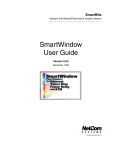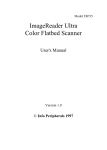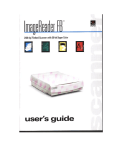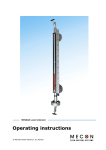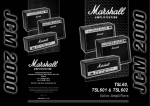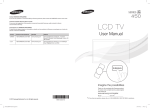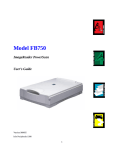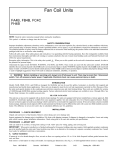Download Compaq ImageReader Express User`s guide
Transcript
ImageReader Express Compact Color Flatbed Scanner User’s Guide P/N DOC-FB4B 799250 Info 580 Division Street Campbell CA, 95008 Phone (408) 538-2500 • Fax (408) 538-2599 Copyright © 1996 – 1997 All rights reserved. No portion of this document may be reproduced without prior written authorization. The Info Technician Copyright © 1994 – 1997 All Rights Reserved The material in this document is for informational purposes only and is subject to change without notice. The manufacturer assumes no responsibility for errors or omissions in this document, nor any damages resulting from the use of the information contained herein. Info and ImageReader Express are trademarks of Info Peripherals. Any other trademarks, registration marks, or brand names mentioned within this publication are the property of their respective owners. i Table of Contents Chapter 1 Introduction ..................................... Welcome ........................................ Using this manual ............................ Assistance ................................. What is TWAIN? ................................... A note about application software ................ Package contents ................................. System requirements ............................... 1-1 1-1 1-1 1-1 1-1 1-2 1-3 1-3 Chapter 2 Scanner Installation and Info Technician ............... Installation ....................................... Connecting the scanner ....................... Using the pass-through ........................ The Info Technician ................................. Installing the device driver ...................... Installing the application software ....................... 2-1 2-1 2-1 2-1 2-2 2-2 2-2 Chapter 3 Using your scanner ............................... Scanning features and controls ........................ Hardware features ........................... Software controls ............................ Scanning images .................................. Select the TWAIN source ...................... The scanning process ......................... Other scanning features ....................... 3-1 3-1 3-1 3-2 3-6 3-8 3-9 3-9 Appendix A GeneralScanningTips................................................................A-1 Troubleshooting ................................. A-1 PrinterProblems................................................................A-2 ErrorMessages...................................................................A-3 Scanner care ............................... A-5 FCC radio frequency interference statement ............... A-5 Limited two year warranty ............................ A-6 i iii Chapter 1 Introduction Welcome Thank you for purchasing the Info ImageReader Express Scanner. This product is the result of our efforts to develop high technology computer peripherals that are easy to use, affordably priced, and that enhance your computing experience. Using this manual This manual includes complete instructions for scanner installation, use, and maintenance. Note that “use,” in this context, refers to scanner operation independent of the task performed with the application software. This guide is organized in a “do as you read” format. For best results, perform the tasks as they are presented. This manual assumes that you have a basic understanding of the DOS and Windows operating system. As a convention, this guide presents all references to guide names or sections in italics, and commands you must type at a command line are presented in a different typeface. Assistance If you experience difficulties and cannot find solutions within this guide, please contact Info’s Technical Support Department at (800) 777-3280, Monday through Friday, between 8:00 AM and 4:30 PM, Pacific time. If you wish, you may fax questions to (408) 538-2577, or email questions to [email protected]. Provide a fax number or email address for return contact. We maintain a BBS at (408) 5382580 that contains the latest updates to our software, as well as a web site at www.infoconnection.com, and fax back system at (408) 538-2585. What is TWAIN? TWAIN is the interface that links the scanner with scanning software applications. TWAIN is an industry standard that enables you to use the ImageReader with any TWAIN-compliant software application. 1-1 With the introduction of Windows 95, the TWAIN specification has been overhauled to take advantage of the 32-bit architecture. When you install our scanner driver under Windows 95, you will have two TWAIN sources — one for 16-bit applications and one for 32-bit applications. Use the following as a guide to select the appropriate source. 16-bit applications are legacy Windows 3.x programs that you are running under Windows 95. InfoCenter and Image Pals 2 GO! image editor are 16-bit applications. 32-bit applications are programs specifically designed for Windows 95, to take advantage of performance enhancements provided by the new architecture. You may experience scanning problems if you do not use the appropriate source before scanning. There is no change to the TWAIN source for Windows 3.x users. Only the 16-bit TWAIN source is installed. A note about application software The scanner hardware by itself is not very useful. It takes a combination of the scanner hardware and application software to perform any task. Before you begin scanning, you need to choose the appropriate application to use for the task at hand. Please read this section to gain an understanding of the types of scanning software there are. Scanning software generally falls into two groups, Graphics (image editing), or OCR (Optical Character Recognition). Each type has specific features designed to address the technical challenges faced in the scanning of graphics or of text. Graphics: Software provides the user with image editing tools for performing extensive modifications to art, photographs, or other continuous tone images. While having the ability to scan text, unlike OCR software it is not designed to specifically identify individual characters. Any image scanned using a graphics program can only be saved in a graphics file format (i.e. TIFF or JPEG). It cannot be saved as an editable text file. Your scanner package contains Image Pals 2GO! image editing software to facilitate your image editing requirements. 1-2 OCR: Software in this category is designed to recognize alphanumeric characters in preparation for export to word processing and desktop publishing applications. In other terms, it creates text files. OCR software will not provide image editing capabilities. If there is no intention of editing a given piece of text (with or without graphics), it may be simpler to scan and save it as a graphic. OCR is one of many scanning control features included in the InfoCenter application software. Additional types of applications are available that offer solutions for special or unique tasks. These include document storage, form scanning, fax utilities, copy utilities, custom screen saver creation, photo album creation, and so on. If applications are intended to link directly to the scanning device, look for the TWAIN-compliant specification. If compliant, they are compatible with Info ImageReader scanners. Package contents Verify that all materials have been received before setting up and using your scanner. This package contains: • ImageReader Express scanner • Interface cable • Power adapter • Quick Start Guide • This User’s Guide • Info’s System Software CD-ROM including installation and application software • Scanner registration card System requirements System requirements are largely dependent on the “work” performed. By work, we are referring to the task or operation performed using the scanner in conjunction with application software. 1-3 Because scanners are capable of inputting large amounts of data in relatively short periods of time, they commonly push computer systems to the limits of their capabilities. Before beginning any scanning task or operation, carefully consider your system’s processing capabilities, especially processor speed, RAM, and available hard disk space. OCR processes, fax operations, and the processing of simple black & white graphics are least demanding. High resolution scanning of large images in full color creates an extreme demand for processor time and memory. When you are scanning with the TWAIN interface, the number labeled image size (calculated in bytes) provides the working file size that is the result of the selected scanning mode, resolution, and image size. Take careful note of this information. Minimum and recommended system requirements are: • 486 processor or 100% compatible • DOS 5.0 or later with Windows 3.1x, or higher • CD-ROM drive • 8 MB RAM minimum; 16 MB RAM recommended • 10 MB available hard disk space; 50 MB recommended • VGA/SVGA monitor with at least 256 color capability, 24 Bit True Color recommended • Enhanced Parallel port 1-4 Chapter 2 Scanner Installation and Info Technician Installation Installation of the scanner is comprised of few steps and designed to be as easy as possible. The following instructions walk you through connecting the scanner and cable. It is important to note that both the scanning hardware and its supporting software (e.g. Info Technician and the included applications) must be installed in order for the scanner to operate. Connecting the scanner Attach the female connector of the interface cable to the port on the scanner labeled Host. Place the scanner unit in the desired location, and route the interface cable to the computer in such a way as to assure it is safe from possible damage due to pinching or crimping. Insert the male connector on the cable into the parallel port on your computer. The cable can only be inserted one way — do not force a connection. Important: The scanner will not function until the device driver is installed. This is loaded when you run the Info Technician, described laterin thischapter. Using the pass-through This scanner is equipped with an additional port for connecting your printer or other parallel device. This way, two devices can share the parallel port, and you won’t be inconvenienced by having to switch cables when you want to use one or the other. To use the pass-through port, connect the printer’s cable to the port labeled Printer on the back of the scanner. Both the scanner and the printer are now sharing the parallel port and can be used at any time, except in tandem. 2-1 The Info Technician The Info Technician is an automatic installation utility that edits and installs the scanner’s device and TWAIN drivers. These drivers provide the link between the scanning hardware, the scanning application, and the computer’s operating system. Installing the device driver Run the Info Technician to install the scanner drivers. To do so: 1. Place the Info Scanner System Software CD-ROM in the CD Rom drive. Select Run from the File Menu in the Windows Program Manager (Windows 3.1x), or select Run after clicking Start on the taskbar (Windows 95). 2. Type d:\install\setup at the command line (substitute the appropriate drive letter if the CD-ROM drive is not the “d” drive). Click OK. 3. Select the Scanner Driver: Click on the picture displaying the Image Reader Express scanner. 4. Click OK to install the TWAIN driver in the “c” drive or substitute the appropriate drive letter for the drive that contains the Windows directory. The screen will inform you that the Installation was Successful. Click Continue to begin the InfoCenter software installation (Figure 2.1). Figure. 2.1 2-2 Installing the application software When the hardware and device driver software are installed, install the InfoCenter application software from the System Software CD. Please refer to the Quick Start Guide for InfoCenter and Image Pals 2 GO! Image Editor installation instructions. Manuals for both applications are also included on the Info System Software CD. Perform Utility Diagnostic After installing the device driver and application software, check that your driver is installed at the correct port address by performing a scanner utility diagnostic. This step will determine if the scanner is recognized by the computer 1. Select Info Tech from the program manager in Windows 3.1x or from the Start menu in Windows 95. 2. From Info Tech select Scanner Utility check the EPP box and click on Verify Port in the Utility window. (Figure 2.2) 3. The diagnostic will search for and connect to correct port ad dress. If the diagnostic is successful you will receive the following message (figure 2.3). Click O.K. and perform a test scan. figure 2.3 2-3 If the diagnostic is unsuccessful you will receive the following message (fig. 2.3) which most commonly indicates that you need to follow the directions below to change the Parallel port option in your computer’s BIOS setup. figure 2.3 In order to ensure the best results possible with your ImageReader Express scanner, you will need to select EPP (Enhanced Parallel Port) mode in your computer’s BIOS or CMOS settings - see instructions below. Enhanced Parallel Port is supported by late model motherboards (i.e. VLB and PCI). Contact your computer manufacturer if you are unsure about whether or not your system supports the EPP mode. If your system does not support the enhanced parallel mode, contact Info Peripherals Inc. at (408) 538-2500 ext. 2534 to order an EPP interface card. Important! Changing your BIOS or CMOS settings can render your computer system inoperable. Use caution to ensure that only the Parallel mode is changed (this will effect you parallel port only). Please consult your computer hardware manual for instructions specific to your system. To Change Your Parallel Port Mode Setting (in most systems): 1. Restart your computer and when in start up mode press your delete key, this will take you to the BIOS Menu. 2. Locate the Parallel Port option, it will tell you what address the parallel port is set for and the mode of the port. 3. Read your screen for instructions on how to change settings, and change your parallel port setting to EPP. 4. Go back to the main menu. 5. Exit and save changes. If you encounter difficulty changing your BIOS setting, please refer to your computer manual or contact your computer manufacturer. 2-4 2-5 Chapter 3 Using your scanner Scanning features and controls Before scanning images, it is important to understand the scanner’s basic hardware features as well as the software controls. Hardware features Power The scanner requires its own power source (use the adapter provided). There is no on/off power switch on the unit. When the scanner is plugged in to a power source, its power is on and the indicator light is lit. Please note: The power light may remain dimly lit even when it is not plugged into a power supply because it receives a small portion of its power from the computer. The scanner is activated when first powered on or when you choose Acquire. By default, the lamp is programmed to remain on even when the scanner is not in use - indicating that power is available. You can use the Lamp Control section contained in the Scanner Utility to adjust the amount of time the scanning light remains on when the scanner is not in use. To adjust the Lamp Control options select Info Tech > Scanner Utility from your Programs menu and click on the Lamp Control tab. Figure 3.1 3-1 Paper loading Place the document to be scanned face down on the scanning glass. Books, magazines and other 3-dimensional objects can be easily scanned as well, by laying them on the scanning glass. With bound materials and other objects, the cover is designed to lift up at the hinge to accommodate the item being scanned. Do not force the cover down when scanning these items, it may break or scratch the glass. Paper size The scanner will handle documents ranging in size from that of a postage stamp to a letter size document (8.5" x 11”), and A4 (8.5” x 11.7”). Paper condition If the sheet to be scanned has any of the following conditions, please take the following precautions before inserting. • Remove paper clips, pins or staples • Let wet paper dry first • Avoid scanning documents with correction fluid (dry or otherwise) This avoids scratching or marring the scanning glass, and ensures years of beautiful scans. Software controls The Info Technician loads a TWAIN-compliant driver. This driver functions as a “user interface” linking the scanning hardware and application software. Scanning is initiated from within the application software. All scanning activities are controlled from the user interface window titled Flatbed Scanner. The Flatbed Scanner window’s Pre-scan command is used to preview the image in order to adjust the scanning area, contrast, and intensity before executing the actual “working” scan. The actual scan is then placed into the application software for viewing, editing, printing, or storage. In this section, the components and controls of the Flatbed Scanner window are explained. 3-2 Fig. 3.2 TWAIN Interface (Using Image Pals 2 GO! software) Preview Window The interface window’s right side displays Pre-scanned images. The Crop Box (dashed line) surrounding the perimeter is used to select the area of the pre-scanned image that you want to scan. Adjusting this area significantly effects the amount of memory used and thus time required to perform the scan. It is always recommended that you adjust the crop box to scan only the portion of the image that you need to scan. Position the pointer over a corner of the crop box, click, hold, and drag the border to adjust the scanning area. Settings The settings box is located in the top portion of your TWAIN window. By clicking on the down arrow you may select from a list of predefined scan settings. These settings represent files containing information about how the scanner should scan the image. Choose the most appropriate setting for your task. For example: If you are scanning a black and white photograph on 8.5” x 11” paper you would select B/W Photo Page (letter) in the Settings menu. These settings can be further modified in the Control Panel and Enhance menu. If your image/document does not meet any of these specifications simply select the default setting from the settings list. Pre-scan and then adjust the crop box and scan options (located in Panel and under the Filters and Advanced menus) accordingly. Click 3-3 on Help in the top portion of the window for more information about scan settings. Gamma Gamma refers to the numerical value for the level of intensity or brightness in the tones of color or grayscale images. As the number increases the tonal intensity increases. Your TWAIN interface allows you to make adjustments for two types of gamma settings. Image Gamma refers to the gamma values that directly affect the outcome of the scan and will be saved with the rest of your scanned image information. This differs from Monitor Gamma which defines how the tones in an image will be displayed on your monitor. Monitor Gamma can be adjusted in the Advanced menu located at the top of the TWAIN window. If the color or tones in your Pre-scanned image are off balance, using the Gamma controls to make adjustments to the pre-scanned image will save you time correcting the image later in an editing application. The Settings menu located above the preview window limits you to Gamma 1.0 or Gamma 1.5 for scanning color or grayscale images. However, The Image Gamma levels for each RGB channel can be balanced individually in the Enhance window (located under Advanced). These changes are effective immediately, and are shown in your pre-scanned image. Image Information Information about your pre-scanned image is displayed in boxes along the bottom of your TWAIN window. Use this information as a guide when determining what scan mode and resolution you want to scan at. The information as displayed from left to right is as follows: • Cursor Position Displays the coordinates of your cursor position as it appears on the image. • Scan Area Coordinates Displays the coordinates at which the top left corner of the cropping box originates. • Scan Area Dimensions Displays the dimensions of the image in inches or centimeters. 3-4 • Image Size Displays the amount of memory that the image will use: Image size = scan mode x resolution x scan area. Tip: Image size can be reduced by cropping pre-scanned image. • Image Measurement Displays unit of image measurement. Can be converted between inches or centimeters by selecting Advanced > Preferences. Pre-scan A Pre-scan is a low resolution scan of your image displayed in the TWAIN interface window only. You do a Pre-scan to make your selections for size, and to make contrast and intensity adjustments. Scan A scan is the actual image captured at the selected settings. The scan does not appear in the preview window, it is displayed in the application’s workspace. Panel View your scanning preferences by clicking the Panel button located in the left portion of your interface window. The scanning control panel (figure 3-3) will appear. This panel allows you to make all of the image adjustments described in the following four pages. Figure 3.3 Scan Mode Your scanning mode options are RGB Color, Gray Scale, and black and white. These selections indicate the amount of data you want to capture for the image. Follow these guidelines when selecting a scan mode from the control panel: Figure 3.4 3-5 RGB Color: Scan color images and photographs in RGB Color mode when you want to capture and reproduce all the color data. To manage file sizes efficiently, take careful note of the guidelines for resolution (described later) when scanning in RGB. The combination of RGB Color and a high dpi can create an extremely large file size, as well as take several minutes to scan. Gray Scale: What is referred to as black and white photographs are actually gray scale images. Different shades of gray are used to make up the whole picture. When you scan these types of images, you want to scan using the gray scale mode. Also use this mode to convert color photographs to black and white. Scanning a color photograph in gray scale will capture the continuous tones. B/W: This mode captures black and white only. Use this mode when scanning single color (usually black) images, such as drawings or sketches, business logos, or text. Resolution Resolution is measured in dots per inch (dpi). The higher the resolution is set, the more detail in your image is captured. There are some guidelines you should follow when determining the resolution to scan at.. On-line graphics: If you are scanning an image to be used on-line, such as the Internet, a BBS or in a multimedia presentation, you needn’t scan any higher than 100 dpi. This is because a monitor’s resolution is either 72 dpi (Mac), or 96 or 120 dpi (PC), and is not capable of displaying a higher resolution. Images scanned at 300 dpi and viewed on a monitor will appear three times as large as the actual image. This enlargement results because your monitor displays images in a 1:1 ratio of pixels (or dots), meaning one dot in the image equals one dot onscreen. At 300 dpi, the image contains 3 times as many dots when displayed on the monitor. Printed images: If you plan to print the images you scan, set the scanning resolution no higher than equal to the resolution of your printer, typically 300 dpi or 600 dpi. This will avoid sizing distortions in your printed image. 3-6 Faxing images: Any image you intend to fax from a PC-based fax modem should be scanned at 200 dpi. Fax machines only receive images at 200 dpi, and some programs may fault if you try to scan at higher resolutions. Refer to the chart below for resolution setting guidelines. IC = InfoCenter, IPG = Image Pals GO! Function Application Scan Mode, Resolution Scan ‘n Fax OCR Color Picture on Monitor Color Picture to Print Copier Function Document Images Word Processor, Scan to Clipboard High Resolution Images Color Image Editing IC IC IC or IPG IPG IC IC IC IPG IPG B&W line art, 200 DPI B&W line art, 300 DPI True Color, 72-100 DPI True Color, 150 DPI Color, 200 DPI Color, GS, B&W, 72 DPI Color, GS, B&W, 72 DPI Color, up to 4800 DPI Color, up to 4800 DPI Scale Scaling allows you to specify an image size before scanning. This option is useful because it allows you to control the image file size - thus minimize scanning time and occupied disk space. It also eliminates the neccesity to change the images size after it is transferred into another application. Inverse This command reverses an image’s display. Black pixels will be white, and white pixels will become black. The resulting image is like a photo negative of the original. Brightness and Contrast These controls adjust the brightness and contrast of the image you are about to scan. Increasing the contrast will sharpen the image by excagerating the images colors or tones. Increase the brightness to lighten the image and compensate for the contrast selection. Experiment with these controls to determine the look you prefer. Usually these controls are adjusted together in a 2:1 ratio of brightness to contrast. 3-7 Scanning images Scanning images with your ImageReader scanner is a relatively simple process. The steps below walk you through selecting the appropriate TWAIN source to use, and then scanning an image or document. If you experience problems during any of these steps, please refer to the appendix, Troubleshooting. You may need to modify the configuration. Select the TWAIN source Before you can scan with your ImageReader, you need to tell the application what scanner you are using. The scanner is referred to as the “source,” and you need to select the appropriate source for the application you are using. Note: In some cases, an application’s User Guide may direct you to use the application’s custom “ImageReader” driver. In these cases, the instructions provided below are inappropriate for that application. Refer to that application’s user guide for scanning instructions. 1. Start the image editing application software in Windows. 2. Choose Select Source from the File menu. 3. Follow the appropriate instructions for the Windows version you are running. Windows 3.1 and 3.11 Select Flatbed Scanner_16 Windows 95 or later Select either Flatbed Scanner_16 or Flatbed Scanner_32 from the Source list, depending on what type of application you are scanning into. Note: If you are using a 16-bit application, and select Flatbed Scanner_32 as your source, you may get a TWAIN error and not be able to scan. Be sure to select the correct source to use with 32-bit applications and 16-bit applications. Refer to Chapter 1, What is TWAIN for more information. 4. Click OK. The application is now set to use your ImageReader Express to scan. 3-8 The scanning process The initiation of the scanning process may vary from application to application. Consult the application’s manual for more information if the steps below don’t result in a scan. The instructions provided in these steps assume the application uses the most common process. To scan an image: 1. Start the TWAIN compliant image editing application in Windows. 2. Select Acquire from the File menu. This displays the Flatbed Scanner window. 3. Place the image face down on the scanner glass. Click Prescan. The prescanned image displays in the Prescan window. 4. Adjust the image as you desire. Make your selections for scan mode, resolution, etc., and use the crop box in the Prescan window to select the area you want to scan. Follow the guidelines described in the previous section to make your selections. Note: If the image is not as large as the Crop box, the additional blank area is also scanned, creating an unnecessarily large file. Be sure to adjust the Crop box to fit the exact area you want to scan. To do so, simply click and drag one of the box corners. 5. When you are satisfied with the selected settings, click Scan. The image is scanned using the selected settings, and transferred into the application’s workspace. 6. Click Cancel to close the Flatbed Scanner window. You are returned to the application, and the scanned image is displayed in the workspace. You may now manipulate, save, print, or fax the image. Other scanning features Your ImageReader scanner is capable of scanning all types of documents and images. The scanning instructions provided here are to ensure the installation is complete and your scanner is working properly. For more detailed instructions about manipulating images once they are scanned, or for using your scanner for OCR, document archiving/retrieval, and faxing, refer to those applications’ manuals. 3-9 3-10 Appendix A General Scanning Tips 16-bit versus 32-bit applications: Image Pals 2 GO! - the image editing software and InfoCenter the scanning control software included with the ImageReader Express scanner- are both16 bit applications. 16 bit applications are supported by Windows 3.1x and Windows 95. Selecting the correct source: Before attempting to scan with your ImageReader Express scanner you need to select the source from which you are scanning. To select your source click on File> Select source or File>Acquire>Select Source (depending on the application you are scanning with). If you will be scanning into a 16 bit application such as InfoCenter or Image Pals 2 GO! image editor you should select the Flatbed ( (16) choice in the “source” dialog box. If you are scanning with a 32 bit application such as Adobe Photoshop you should select Flatbed (32). If you do not select the correct source you may receive an error message when attempting to scan or run into complications when trying to transfer your scanned image. Troubleshooting Scanner does not turn on Confirm that the scanner’s power adapter is plugged into a power source and the indicator light is on. Scanner turns on but does not respond Reinstall the Info Technician to ensure the driver is properly loaded or restart your computer to reset the system. Check the cable connections on the scanner and parallel port. Be sure the cable is plugged into the port labeled Host on the back of the scanner. Check that the parallel connection on the computer is secure. Scans extremely slow This is common when scanning true color at high resolutions. Follow the setting guidelines in Chapter 3 for the particular scanning task. Avoid scanning at higher settings than necessary—this improves A-1 performance. If you still experience problems with your scanning speed, follow the directions on page A-2 and A-3 to verify the scanner’s port address and possibly change your computer’s BIOS setup. Printer Problems? Cannot print to printer Check the cable connections on the printer and the scanner. Be sure the cable is plugged into the port marked Printer on the back of the scanner. Bi-Directional Printers The parallel port does not support Bi-directional printers such as those made by Hewlett-Packard. Therefore you will need to change your printer port in your computer’s BIOS or CMOS settings to EPP or SPP instead of bi-directional. In this case, you may also need to disable your printer’s bi-directional printing option (refer to your printer manual for instructions) Refer to page A-3 for instructions on changing your computer’s parallel port mode. About the pass-through port The ImageReader Express and ImageReader Elite EPP scanners are both conveniently equipped with a pass-through port. This port allows you to connect any other parallel port device such as a printer to the scanner so that they can share the same port from your computer. To use the pass-through port, connect the printer’s cable to the port labeled Printer on the back of the scanner. Both the scanner and the printer are now sharing the same parallel port and can be used at any time, except in tandem. TWAIN Errors If your computer cannot find or does not recognize the scanner: 1. Some computer systems will not recognize an installed scanner unless the computer has completed it start-process entirely BEFORE the scanner is plugged-in. Turn off the computer and un-plug the scanner’s AC power cord from the power outlet, then turn on the computer. After the computer has completed start-up and is running windows, plug-in scanner and attempt scan. A-2 2. Be sure you have selected the appropriate source for the application you are scanning into. Most 32-bit applications require you use the Flatbed Scanner (32) source, and 16-bit applications require you use the Flatbed Scanner (16) source. 3. If your computer cannot find or does not recognize the scanner: a) Check your cable connection and retry scanning. b) Verify your port by selecting Info Tech from the program manager in Windows 3.1x or from the Start menu in Windows 95. From Info Tech select Scanner Utility and click Verify Port in the Utility window. This feature will search for and connect to correct port address. Error messages “Image Transfer Failed” This error message indicates that the selected scan settings have created a file size that exceeds available disk space. Reduce the dpi, image size, or select a lower mode to reduce the file size. “Error 82 Scanner not Found” message when attempting a scan This error is most common with Compaq and Aptiva systems or any system not equipped with an enhanced parallel port. Check with your computer manufacturer to verify if your system supports the Enhanced Parallel Port mode (if your system is not equipped with an EPP card call (408) 538-2500 or fax (408) 538-2577 to order an EPP interface card). If your system supports EPP, check for the following situations: 1. The computer detects a conflict with the scanners I/O ad dress. Perform the following fix: Run your flatbed utility program and click the verify port icon. If the utility cannot find the scanner, you may need to change the parallel port mode in your computer’s BIOS or CMOS setup so that it matches the setting of your scanner driver. In this case refer to step 2. A-3 2. Check your computer’s BIOS setup to make sure that your printer port is set for EPP or SPP. The ImageReader Express scanner will work on ports that are set for EPP and SPP. The fastest of the modes is EPP. Follow these directions to change your computers parallel port mode. Changing Your Parallel Port Mode 1. Open your System setup (BIOS or CMOS) (check your computer manual for instructions on how to do this). 2. Go to the area in which you can change the parallel mode settings and change the LPT type to EPP or SPP. 3. Save your changes and exit. Now reboot your computer and attempt to scan again. Grainy images Check the video driver settings within Windows. The difference between 16 colors viewed and 256 colors viewed is dramatic. Select 256 Colors (or higher) if the system hardware supports such. Specs or lines across scanning area Open the document feed cover and clean the glass with a soft lens cloth. A-4 Scanner care Info ImageReader scanners are designed to provide years of trouble free service. To assist in realizing this end, follow the guidelines listed below. 1. Avoid using the scanner in a dusty environment, and keep it as dust-free as possible. 2. If necessary, clean the scanner glass with a soft lens cloth. 3. Do not scan documents with correction fluid. This will cause spotting on the scanner glass. 4. Do not scan documents with paper clips or staples. The glass may become scratched. 5. Don’t touch the scanner glass. Fingerprints or scratches will show up as unwanted marks on your scanned image. 6. Don’t remove the scanner case. There are no consumer serviceable parts inside. There is a danger of electric shock, and the warranty will be void. 7. Don’t move the scanner excessively or subject it to excessive vibration, as the lens focus may become distorted. 8. The scanner operates best in temperatures of 10°C to 40°C (50°F to 104°F). FCC radio frequency interference statement This equipment has been tested and found to comply with the limits for a Class B digital device, pursuant to Part 15 of the FCC rules. These limits are designed to provide reasonable protection against harmful interference in a residential installation. This equipment generates, uses and can radiate radio frequency energy and, if not installed and used in accordance with the instructions, may cause harmful interference to radio communications. However, there is no guarantee that interference will not occur in a particular installation. If this equipment does cause harmful interference to radio or television reception (which can be determined by turning the equipment off and on), the user is encouraged to try to correct the interference by one or more of the following measures: A-5 • Changes or modifications not expressly approved by the manufacturer or authorized service center could void the user’s authority to operate this equipment. • Reorient or relocate the receiving antenna • Increase the separation between the equipment and receiver. • Connect the equipment to an outlet on a circuit different from that which the receiver is connected. • Shielded interconnect cables and shielded power cord which are supplied with this equipment must be employed with this equipment to ensure compliance with the pertinent RF emission limits governing this device. • Consult the dealer or an experienced radio/TV technician for help if the conditions persist. Limited two year warranty Info warrants this scanner to be free of manufacturing defects, both materials and workmanship, for a period of two years from the date of original purchase. This warranty applies only to the original purchaser. In the event of a defect, Info will repair this product free of charge, including parts, labor, and return postage. This warranty does not cover damage, loss, abuse, misuse, unauthorized repair, shipping damage, natural phenomena, or effects of use other than intended. Info is not responsible for consequential damages, including but not limited to, lost profits, lost sales, loss of use, or injury to property. For scanner service, contact us at (800) 777-3280, and request a Return Authorization (RA) number. Repackage the product in its original packing container (for protection), and return postage prepaid to: Info Service Center 580 Division Street Campbell, CA 95008 Include an address, phone number, the RA number, and a description of the scanner’s defect. Enclose a copy of the original purchase receipt to verify warranty eligibility. Write the RA number legibly on the outside of the package. A-6





























